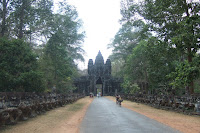
Travel Date 9th March 2008
Click on any picture to see a large version.
Click on any picture to see a large version.
I just realised that I had slipped back to Bangkok without mentioning my afternoon wanderings through Angkor Thom and the Bayon.



 Possibly that's because, after all the walking I did in Angkor Wat I spent most of the afternoon in the back of the tuk-tuk, travelling the lazy way from site to site.
Possibly that's because, after all the walking I did in Angkor Wat I spent most of the afternoon in the back of the tuk-tuk, travelling the lazy way from site to site. 

 To be honest, my feet were killing me; I had bought good walking shoes for the trip but I should have spent a little longer breaking them in before the trip.
To be honest, my feet were killing me; I had bought good walking shoes for the trip but I should have spent a little longer breaking them in before the trip.However, I did get out to wander around the Bayon.

 Have you ever felt you were being watched? The Khmers certainly must have back in the days of Jayavarman VII. Talk about Big Brother. I'll explain why in a minute, but first a brief history.
Have you ever felt you were being watched? The Khmers certainly must have back in the days of Jayavarman VII. Talk about Big Brother. I'll explain why in a minute, but first a brief history.The Bayon is a Buddhist temple in the centre of Angkor Thom, next to Angkor Wat. Angkor Thom was the walled capital city of the Khmer Empire at one of it's peaks, from about 1181 AD when Jayavarman VII commenced building both the city and the Bayon. It is one of the latest structures built in the Angkor complex and one of the few Buddhist temples. Angkor Wat was built earlier and was originally a Hindu complex, although later Buddhist influences appeared.

 The Bayon was built as a Mahayana Buddhist temple originally, and later became a Theravada Buddhist temple. However, the influences of the earlier Hindu sculptors also infiltrate the bas reliefs and parts of the structure. Even some Chinese faces appear as warriors in the bas reliefs.
The Bayon was built as a Mahayana Buddhist temple originally, and later became a Theravada Buddhist temple. However, the influences of the earlier Hindu sculptors also infiltrate the bas reliefs and parts of the structure. Even some Chinese faces appear as warriors in the bas reliefs.The most fascinating aspect of the Bayon is the more than 200 giant faces watching you wherever you go. They even appear on outbuildings and near the great walls and gates. There are several theories about the faces. Some say they are a representation of the Mahayana bodhisattva Avalokitesvara. However, they bear a striking likeness to the images left of Jayavarman VII, so I tend to go along with those that believe he used his face to be the face of the bodhisattva deliberately to extend and reinforce the devaraja cult of the king as a god, first established by the past rulers who built Hindu Angkor Wat.

 But, wherever you go, he is watching. The story is that every face sees some distant part of the Empire, so all of his subjects knew that the god-king was watching.
But, wherever you go, he is watching. The story is that every face sees some distant part of the Empire, so all of his subjects knew that the god-king was watching.After I left Bayon with my sore feet, I stopped for photo opportunities at the outlying temples and structures, but I'm afraid I haven't got details for most of them. The large picture at the top and the final bas-reliefs below were from an interesting temple constructed from brick, north of Siem Reap and East of Angkor Thom. Interesting because of the quite different construction materials and methods.

 A final note on the Khmer Empire. The size, complexity, spirituality, artistic merit, engineering and architectural brilliance of this lost civilisation was awesome to me. Repeatedly in my travels I have been staggered by the achievements of past civilisations, and also, sadly, reflected on the temporary nature of those civilisations. Angkor was literally lost to the jungle for centuries.
A final note on the Khmer Empire. The size, complexity, spirituality, artistic merit, engineering and architectural brilliance of this lost civilisation was awesome to me. Repeatedly in my travels I have been staggered by the achievements of past civilisations, and also, sadly, reflected on the temporary nature of those civilisations. Angkor was literally lost to the jungle for centuries. 

 I also wonder on the implications that history holds for us. Who knows, some tourist in 3100 may be musing on the same things as he or she (or it) wonders what sort of temple the Sydney Opera House was and who was worshipped there. Or at the New York Stock Exchange, submerged under 100 meters of water.
I also wonder on the implications that history holds for us. Who knows, some tourist in 3100 may be musing on the same things as he or she (or it) wonders what sort of temple the Sydney Opera House was and who was worshipped there. Or at the New York Stock Exchange, submerged under 100 meters of water.
Cheers, Alan






No comments:
Post a Comment